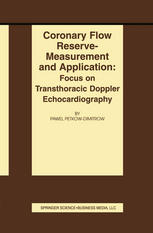

Most ebook files are in PDF format, so you can easily read them using various software such as Foxit Reader or directly on the Google Chrome browser.
Some ebook files are released by publishers in other formats such as .awz, .mobi, .epub, .fb2, etc. You may need to install specific software to read these formats on mobile/PC, such as Calibre.
Please read the tutorial at this link: https://ebookbell.com/faq
We offer FREE conversion to the popular formats you request; however, this may take some time. Therefore, right after payment, please email us, and we will try to provide the service as quickly as possible.
For some exceptional file formats or broken links (if any), please refrain from opening any disputes. Instead, email us first, and we will try to assist within a maximum of 6 hours.
EbookBell Team

4.3
78 reviewsCoronary flow reserve is an important functional parameter to understand the pathophysiology of coronary circulation. Coronary flow reserve measurement is used to assess epicardial coronary stenoses or to examine the integrity of microvascular circulation. An appreciation of coronary physiology is an integral part of clinical decision-making for cardiologists treating patients with coronary artery disease. The pioneering research efforts of Dr Lance Gould, who explored the relationship between the anatomic severity of a stenosis and its flow resistance (59;60) , have been transferred to clinical practice (94; 194). In the absence of stenosis in epicardial coronary artery, the coronary flow reserve may be decreased when coronary microvascular circulation is compromised by arterial hypertension with or without left ventricular hypertrophy, diabetes mellitus, hypercholesterolemia, or other diseases. Several techniques have been established for measuring coronary flow reserve. However, these techniques are either invasive (intracoronary Doppler flow wire), highly expensive and scarcely available (Positron Emission Tomography - PET) or semi-invasive and causing patient discomfort (transesophageal Doppler echocardiography), thus their clinical use is limited. Because of the clinical importance of coronary flow reserve there is a need for a simple, noninvasive, repeatable and inexpensive tool capable of this functional evaluation. This monograph focuses on the assessment of coronary flow reserve using transthoracic Doppler echocardiography - the technique fulfilling the above-mentioned criteria. Transthoracic Doppler echocardiography has become a popular tool evolving from a research to diagnostic technique applied in everyday practice.